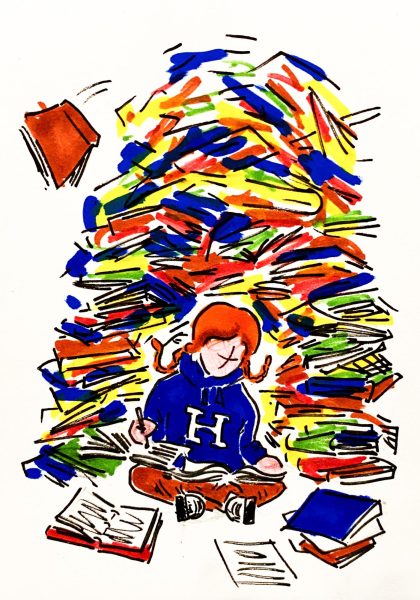Studio Arts: Then and Now
Do you ever wonder what it was like to be a studio arts student at the school before there was a Humanities program or the current art wing?
In the school’s first 38 years, studio art (ceramics, drawing, painting, etc.) was not offered. However, in the years since, numerous courses and disciplines have been added, and the facilities have moved and upgraded multiple times. Mr. Charles Noyes, instructor in art, said that “everything has changed” since his experience as an art student at the school in the late 1970s.
Early in its time at the school, studio art struggled to receive the respect of “traditional” academic courses; during Mr. Noyes’s time as a student, academic classes were referred to as ‘solids’, whereas arts were called ‘softs.’ Today, the program offers 19 courses, starting with Humanities for Preps and Lower Mids and progressing to AP-level classes. Mr. Faus said, “We feel the arts in general and [visual] art in particular are essential and equal partners in our academic curriculum.”
In 1974, the school welcomed women to campus, and Ms. Blanche Hoar, head of the art program, along with five other female teachers, joined the faculty. According to Mr. Noyes, Ms. Hoar made it clear to students that the teacher was always correct at the end of the day. Now, teachers encourage students to make discoveries by themselves and to engage in self-reflection and constructive critique of their own works and that of their peers’.
Ms. Hoar’s retirement precipitated Mr. Noyes’ arrival in 1986, Mr. Brad Faus’, program director of art, in 1987, and those of Ms. Marjory Reid in 1987 and ceramist Ms. Delores Coan in 1980. By hiring practicing artists like Mr. Noyes, who had little formal teaching experience before he arrived, the school sought to expand the program in new directions.
The biggest change to the curriculum in recent years has been the integration of studio arts into the Humanities Program. Ms. Moore, instructor in art and co-director of Tremaine Art Gallery, said, “The arts faculty has been focused on building cross-disciplinary connections and experiential learning. The students carry those concept-building skills and collective learning experiences to their work in the upper-level electives.” Students now connect the content they are learning in philosophy, English, and history to the art they learn about and the art they create themselves. Mr. Noyes said, “I love the Humanities program.”
Students frequently take advantage of the opportunity to submit pieces to national and international competitions, some even making it to the Kennedy Center in Washington D.C. Mr. Noyes said, “Though [external] recognition is great and reaffirming, I think about the accomplishments like students inspiring other students.” Art students make numerous contributions to the school community, including in student-run publications like ink. and in the artwork that lines the halls of Main Building.
One of the most recent major changes to the program has been the renovation of the art studios. Over the years, arts studios have been located in Harris House basement, Coy basement, the current Hatch Classroom on the library’s third floor, and now in the Class of 2018 Cullman Art Wing in the Main Building. The new, visually appealing space has provided students with a welcoming and functional environment. The refurbished studios look out to the lake for inspiration. Mr. D’Ambrosio, instructor in history, philosophy, and religion, Ms. Moore, Mr. Noyes, and Ms. Owen, instructor in ceramics, contributed to the renovation, with architects Pilar Proffitt and Rob Bristow P’18, ’20 designing the space.
Constant evolution in faculty, curriculum, and facilities has benefited the school’s ever-growing studio arts program, allowing the program to keep up with the changing times. In today’s age of technology, Mr. Faus hopes to see more digital media offerings added in the future, noting that the recent addition of the Class of 2017 EFX Lab has proven successful for classes like architecture.





